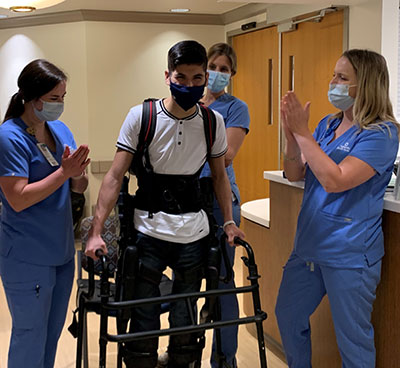Severely injured teen athlete returning home
Five weeks after a near-death vehicle crash that crushed his spinal cord, 16-year old Ernesto Martinez is able to stand upright and move his legs with the help of specialized, exoskeleton equipment. Today the United High School athlete from Laredo was discharged from University Hospital’s Pediatric Inpatient Rehabilitation Unit, where therapists are working to improve his mobility and strength. They call his continued recovery a remarkable success.
Ernesto, who goes by the name Ernie, was injured Feb. 14, during the recent winter freeze. The truck he and his father were riding in hit a patch of ice and flipped over several times. Ernie was wearing a seat belt, but it dislodged and he was thrown from the vehicle.
“I thought I was going to be fine,” Ernie said, recalling the accident. “But, when I tried getting up, I couldn’t feel my legs.”
Following the accident, Ernie was rushed from Laredo to University Hospital’s Level 1 Pediatric Trauma Center. Surgeons saved his life, though he was paralyzed from the waist down. The trauma center is the only one of its kind in South Texas, with round-the-clock specialists able to treat the most severely injured children.
In October 2019, University Hospital opened its Pediatric Inpatient Rehabilitation Unit, so children with severe injuries would not have to move from the trauma center to a different facility for rehabilitation therapy. Dr. Jeannie Harden, the medical director of the rehabilitation unit for children, says providing inpatient rehab in the same complex as the trauma center allows for a “continuity of care.” The child’s surgical team can more closely consult with therapists.
The exoskeleton equipment Ernie uses is a sturdy, wearable machine that supports a person unable to stand upright on their own. Straps and special braces attached to a rigid frame provide support for key areas of the body, while motors help move the patient’s hips and knees forward.
“Standing allows him to put weight on his bones, and putting that pressure on his bones helps preserve bone health,” explained Dr. Harden. Standing also helps stretch muscles and provide a morale boost for a patient who would otherwise be in a wheel chair.
In his last exoskeleton therapy session before heading home, Ernie walked the rehab course faster than ever before. He completed a distance that usually takes him 25 minutes in just 11 minutes.
The teen will be returning frequently to University Hospital to continue working with his doctor and therapists who say he is making great advances.
“My goal is to do as much therapy as I can,” he said. “My goal is to get my legs back.”
Dr. Harden said she believes Ernie’s hard work and positive outlook is paying off, and will result in him being “very successful in life.”
“He is going to have a full life. He’s just going to do things a little differently,” she said.

